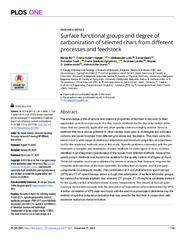Приказ основних података о документу
Surface functional groups and degree of carbonization of selected chars from different processes and feedstock
| dc.creator | Ilić, Marija | |
| dc.creator | Haegel, Franz-Hubert | |
| dc.creator | Lolić, Aleksandar | |
| dc.creator | Nedić, Zoran | |
| dc.creator | Tosti, Tomislav | |
| dc.creator | Ignjatović, Ivana Sredović | |
| dc.creator | Linden, Andreas | |
| dc.creator | Jablonowski, Nicolai D. | |
| dc.creator | Hartmann, Heinrich | |
| dc.date.accessioned | 2022-11-30T12:48:46Z | |
| dc.date.available | 2022-11-30T12:48:46Z | |
| dc.date.issued | 2022 | |
| dc.identifier.issn | 1932-6203 | |
| dc.identifier.uri | http://aspace.agrif.bg.ac.rs/handle/123456789/6225 | |
| dc.description.abstract | The knowledge of the structural and chemical properties of biochars is decisive for their application as technical products. For this reason, methods for the characterization of biochars that are generally applicable and allow quality control are highly desired. Several methods that have shown potential in other studies were used to investigate two activated carbons and seven biochars from different processes and feedstock. The chars were chosen to cover a wide range of chemical composition and structural properties as a hardness test for the analytical methods used in this study. Specific problems connected with the pretreatment of samples and drawbacks of some methods for some types of chars could be identified in an integrated consideration of the results from different methods. None of the spectroscopic methods was found to be suitable for the quality control of all types of chars. The most valuable results were obtained by chemical analysis that, however, required the complete determination of the main elements, including that of oxygen, and of inorganic components for adequate results. The combination of X-ray photoelectron spectroscopy (XPS) and FT-IR spectroscopy allows a rough characterization of surface functional groups, but cannot discriminate aliphatic and aromatic OH groups. FT-IR might be a suitable method for the quality control of biochars made at lower temperature. The results of Raman spectroscopy did not well correlate with the amount of sp2 hybridized carbon determined by XPS. A better correlation of XPS data was found with the electrical polarization determined by the method of spectral induced polarization that was used for the first time in conjunction with extensive analytical characterization. © 2022 Ilić et al. This is an open access article distributed under the terms of the Creative Commons Attribution License, which permits unrestricted use, distribution, and reproduction in any medium, provided the original author and source are credited. | |
| dc.language | English | |
| dc.relation | info:eu-repo/grantAgreement/MESTD/Basic Research (BR or ON)/172051/RS// | |
| dc.rights | openAccess | |
| dc.rights.uri | https://creativecommons.org/licenses/by/4.0/ | |
| dc.source | PLoS ONE | |
| dc.source | PLoS ONE | |
| dc.title | Surface functional groups and degree of carbonization of selected chars from different processes and feedstock | |
| dc.type | article | en |
| dc.rights.license | BY | |
| dc.citation.issue | 11 November | |
| dc.citation.rank | M22 | |
| dc.citation.volume | 17 | |
| dc.identifier.doi | 10.1371/journal.pone.0277365 | |
| dc.identifier.fulltext | http://aspace.agrif.bg.ac.rs/bitstream/id/24194/Surface_functional_groups_pub_2022.pdf | |
| dc.type.version | publishedVersion |


